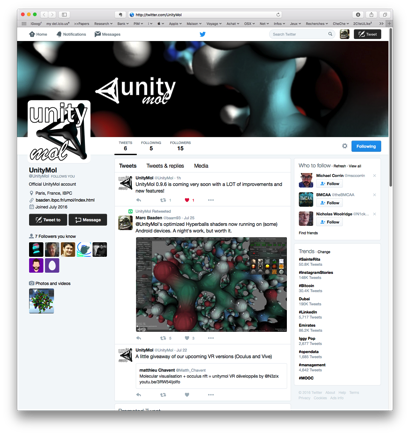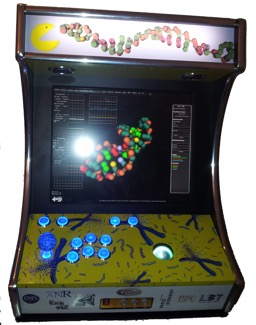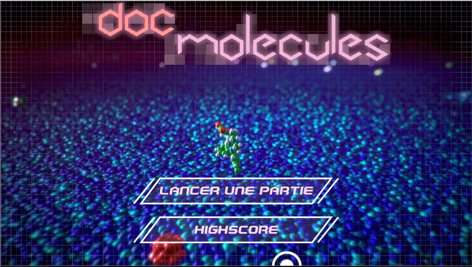UnityMol
Demonstrators and materials for upcoming Nii Shonan meeting
22/08/16 10:25 Rangé dans: UnityMol | Conferences
A selection of demonstrators and material for thought for the upcoming Nii Shonan meeting on Web-based Molecular Graphics is provided through the webpage baaden.ibpc.fr/ns16/. It comprises
- a UnityMol WebGL demonstrator
- an example 360 degrees stereoscopic 3D molecular panorama
- ideas and screenshots about the HyperBalls shaders
- Breakout topic suggestions
New additions to the image gallery!
A sneak peak of upcoming features such as ambient occlusion as well as screenshots from the just released 0.9.6 version were added to the gallery. Check it out! This also works on (some) android devices and within a WebGL context.
UnityMol 0.9.6 builds released
We released binary builds of UnityMol version 0.9.6. They are available from the sourceforge download page https://sourceforge.net/projects/unitymol/files/UnityMol-0.9.6/. Builds are available for Mac OSX, Windows and Linux.
The 0.9.6 release embeds Artemis version Alpha 2.2 and VRPN plugin version Beta 1. There are a lot of deep changes to the code in this release. The overall performance should be greatly improved. Loading PDB files is way quicker, the framerate is drastically improved.Read more...
The 0.9.6 release embeds Artemis version Alpha 2.2 and VRPN plugin version Beta 1. There are a lot of deep changes to the code in this release. The overall performance should be greatly improved. Loading PDB files is way quicker, the framerate is drastically improved.Read more...
UnityMol on twitter and on gitter!
20/07/16 10:30 Rangé dans: UnityMol
UnityMol is now on twitter! Check out the twitter page either from the link in the sidebar to your left, or directly from http://twitter.com/UnityMol. There is also a chat room available on gitter.


UnityMol 0.9.5 builds released
We released binary builds of a stabilized UnityMol version 0.9.5. They are available from the source forge download page https://sourceforge.net/projects/unitymol/files/UnityMol-0.9.5/. Builds are available for Mac OSX, Windows and Linux.Read more...
An Arcade machine for the HiRE-RNA Contest
In the HiRE-RNA Contest, participants are asked to manipulate RNA structures interactively. These molecules are found in living cells, are very similar to DNA, but perform other functions. Run Molecular Dynamics Simulations at home, pull atoms and discover how these molecules behave and carry out their biological function by means of a molecular visualization software: UnityMol. Participants submit their simulated RNA structures that are evaluated and scored based on energy calculations through our website https://hirerna.galaxy.ibpc.fr.


DocMolecules, the first serious game based on UnityMol
Doc Molecules was conceived for an Arcade machine with a haptic arm enabling a touch sensation to construct molecular assemblies. By exploring the mode of action of a drug that is frequently prescribed to combat allergies, the DocMolecule player moves his way up through visualisation and manipulation of molecules. DocMolecules is a combination of UnityMol and Biospring, a physical simulation engine designed for research purposes and reused here to dock molecules together and score the player's achievements.

DocMolecules is a joint project coordinated by Espace des Sciences in Rennes, together with University of Rennes and Polymorph software. We provided the underlying softwares, both UnityMol and BioSpring, as well as scientific advice.

DocMolecules is a joint project coordinated by Espace des Sciences in Rennes, together with University of Rennes and Polymorph software. We provided the underlying softwares, both UnityMol and BioSpring, as well as scientific advice.
DocMolecules obtains igamer award!
DocMolecules and our Arcade machine together obtained the iGamer 2015 Student/Research/Academic prize from the public. Great! See iGamer Tweet and final photo, or the news from our colleagues in Rennes (in French, though).


UnityMol website update
04/02/16 05:37 Rangé dans: UnityMol
Long overdue, the website was updated and the latest news was added. The UnityMol developer doc was updated.
UnityMol@iGAM4ER by Citizens of Science
We met up with Marc Baaden at iGAM4ER 2015 (http://igam4er.org/) to talk about UnityMol (http://www.baaden.ibpc.fr/umol/ )—a game development kit for molecules, created by Marc and his colleagues at CNRS, where Marc is a research director in Computational Chemistry (http://www.baaden.ibpc.fr). You can check out the video interview on Youtube (https://www.youtube.com/watch?v=33AAHPmEfPE).
UnityMol: interactive and ludic visual manipulation of coarse-grained RNA and other biomolecules
At the 1st International Workshop on Virtual and Augmented Reality for Molecular Science (VARMS@IEEEVR), 2015 IEEE, we presented a general software architecture to carry out interactive molecular simulations in a game engine environment. Our implementation is based on the UnityMol framework and the HireRNA physics engine. With UnityMol, we pursue the goal to create an interactive virtual laboratory enabling researchers in biology to visualize biomolecular systems, run simulations and interact with physical models and data. Similarly, UnityMol enables game designers to build scientifically accurate molecular scenarios. We discuss four case studies, from simulation setup via immersive experiments, force-induced unfolding of RNA to teaching and collaborative research applications. Visual effects enrich the dynamic and immersive aspects. We combine an appealing visual feedback with a set of analysis features to extract information about properties of the fascinating biomolecular systems under study. Access to various input devices enables a natural interaction with the simulation.
Full citation is S. Doutreligne, C. Gageat, T. Cragnolini, A. Taly, S. Pasquali, P. Derreumaux, M. Baaden, "UnityMol: interactive and ludic visual manipulation of coarse-grained RNA and other biomolecules," Virtual and Augmented Reality for Molecular Science (VARMS@IEEEVR), 2015 IEEE 1st International Workshop on , pp.1-6, 24 March 2015 doi: 10.1109/VARMS.2015.7151718
Full citation is S. Doutreligne, C. Gageat, T. Cragnolini, A. Taly, S. Pasquali, P. Derreumaux, M. Baaden, "UnityMol: interactive and ludic visual manipulation of coarse-grained RNA and other biomolecules," Virtual and Augmented Reality for Molecular Science (VARMS@IEEEVR), 2015 IEEE 1st International Workshop on , pp.1-6, 24 March 2015 doi: 10.1109/VARMS.2015.7151718
UnityMol @ Large Data Analysis and Visualization (LDAV), 2014 IEEE Symposium
09/11/14 01:30 Rangé dans: UnityMol | Conferences
Most recently, we have extended UnityMol to be able to drive VR devices such as haptic joysticks and spacenavigator and manage simulations interactively, for instance un-/refolding of small RNA fragments atcoarse-grained level. At this symposium we presented UnityMol: Interactive scientific visualization for integrative biology. A broad challenge facing scientists today is the availability of huge amounts of data from various sources. Computers are required to store, analyze, explore and represent these data in order to extract useful information. With UnityMol, we pursue the ambitious goal to create an interactive virtual laboratory enabling researchers in biology to visualize biomolecular systems, run simulations and interact with physical models and data. Visual effects can enrich the dynamic and immersive aspects. Ultimately, we want to combine an appealing visual feedback already in place with a set of analysis features to extract information about properties of the fascinating biomolecular systems under study.
By Doutreligne, S. ; Cragnolini, T. ; Pasquali, S. ; Derreumaux, P. ; Baaden, M. (Lab. de Biochimie Theor., Univ. Paris Diderot, Paris, France)
Published in: 2014 IEEE 4th Symposium on Large Data Analysis and Visualization (LDAV), 9-10 Nov. 2014, Page(s): 109 - 110. DOI:10.1109/LDAV.2014.7013213
Check here for a two-page PDF version.
By Doutreligne, S. ; Cragnolini, T. ; Pasquali, S. ; Derreumaux, P. ; Baaden, M. (Lab. de Biochimie Theor., Univ. Paris Diderot, Paris, France)
Published in: 2014 IEEE 4th Symposium on Large Data Analysis and Visualization (LDAV), 9-10 Nov. 2014, Page(s): 109 - 110. DOI:10.1109/LDAV.2014.7013213
Check here for a two-page PDF version.
UnityMol wins gold medal at iGam4er 2014
Yes, we did it! Gold medal. So cool. Thanks to Thibault, Sébastien, Samuela, Serge and Anne!


SweetUnityMol by Thibault Tubiana wins Skinner poster prize!
The best student poster Skinner prize was awarded to Thibault Tubiana at the Faraday Discussion #169 (Nottingham - England) for Sweet UnityMol, molecular graphics for glycoscience.
UnityMol / SweetUnityMol manual available
A first (still incomplete and work-in-progress) user manual was put together here: http://www.baaden.ibpc.fr/pub/fvnano/umol-manual.pdf.
Three-dimensional representations of complex carbohydrates and polysaccharides—SweetUnityMol: A video game-based computer graphic software
SweetUnityMol was just published in Glycobiology (2015) 25 (5): 483-491. doi: 10.1093/glycob/cwu133.
A molecular visualization program tailored to deal with the range of 3D structures of complex carbohydrates and polysaccharides, either alone or in their interactions with other biomacromolecules, has been developed using advanced technologies elaborated by the video games industry. All the specific structural features displayed by the simplest to the most complex carbohydrate molecules have been considered and can be depicted. This concerns the monosaccharide identification and classification, conformations, location in single or multiple branched chains, depiction of secondary structural elements and the essential constituting elements in very complex structures. Particular attention was given to cope with the accepted nomenclature and pictorial representation used in glycoscience. This achievement provides a continuum between the most popular ways to depict the primary structures of complex carbohydrates to visualizing their 3D structures while giving the users many options to select the most appropriate modes of representations including new features such as those provided by the use of textures to depict some molecular properties. These developments are incorporated in a stand-alone viewer capable of displaying molecular structures, biomacromolecule surfaces and complex interactions of biomacromolecules, with powerful, artistic and illustrative rendering methods. They result in an open source software compatible with multiple platforms, i.e., Windows, MacOS and Linux operating systems, web pages, and producing publication-quality figures. The algorithms and visualization enhancements are demonstrated using a variety of carbohydrate molecules, from glycan determinants to glycoproteins and complex protein–carbohydrate interactions, as well as very complex mega-oligosaccharides and bacterial polysaccharides and multi-stranded polysaccharide architectures.
Background: In Nature, carbohydrates form an important family of biomolecules. Carbohydrates, in the form of polysaccharides, glycopeptides, glycolipids, glycosaminoglycans, proteoglycans, or other glycoconjugates have long been recognize to participate in many biological processes. They can be present in very diverse and complex forms. In a similar fashion to proteins with amino acids, we can build complex carbohydrates from individual units: monosaccharides. But whereas the proteic alphabet is made of “only” 20 letters, around 120 monosaccharides are known and the fact that they can be linked through different positions adds even more complexity to the whole construction process.
Methods: Using the molecular visualization software UnityMol engine it is easy to represent proteins, RNA/DNA and biological networks. UnityMol is based on a new molecular representation called HyperBalls[2] properties to draw very large complexes of several thousand atoms without screen lag. based on the Unity3D video game that uses graphical and shader properties to draw very large complexes of several thousand atoms without screen lag.
A molecular visualization program tailored to deal with the range of 3D structures of complex carbohydrates and polysaccharides, either alone or in their interactions with other biomacromolecules, has been developed using advanced technologies elaborated by the video games industry. All the specific structural features displayed by the simplest to the most complex carbohydrate molecules have been considered and can be depicted. This concerns the monosaccharide identification and classification, conformations, location in single or multiple branched chains, depiction of secondary structural elements and the essential constituting elements in very complex structures. Particular attention was given to cope with the accepted nomenclature and pictorial representation used in glycoscience. This achievement provides a continuum between the most popular ways to depict the primary structures of complex carbohydrates to visualizing their 3D structures while giving the users many options to select the most appropriate modes of representations including new features such as those provided by the use of textures to depict some molecular properties. These developments are incorporated in a stand-alone viewer capable of displaying molecular structures, biomacromolecule surfaces and complex interactions of biomacromolecules, with powerful, artistic and illustrative rendering methods. They result in an open source software compatible with multiple platforms, i.e., Windows, MacOS and Linux operating systems, web pages, and producing publication-quality figures. The algorithms and visualization enhancements are demonstrated using a variety of carbohydrate molecules, from glycan determinants to glycoproteins and complex protein–carbohydrate interactions, as well as very complex mega-oligosaccharides and bacterial polysaccharides and multi-stranded polysaccharide architectures.
Background: In Nature, carbohydrates form an important family of biomolecules. Carbohydrates, in the form of polysaccharides, glycopeptides, glycolipids, glycosaminoglycans, proteoglycans, or other glycoconjugates have long been recognize to participate in many biological processes. They can be present in very diverse and complex forms. In a similar fashion to proteins with amino acids, we can build complex carbohydrates from individual units: monosaccharides. But whereas the proteic alphabet is made of “only” 20 letters, around 120 monosaccharides are known and the fact that they can be linked through different positions adds even more complexity to the whole construction process.
Methods: Using the molecular visualization software UnityMol engine it is easy to represent proteins, RNA/DNA and biological networks. UnityMol is based on a new molecular representation called HyperBalls[2] properties to draw very large complexes of several thousand atoms without screen lag. based on the Unity3D video game that uses graphical and shader properties to draw very large complexes of several thousand atoms without screen lag.
UnityMol website goes online
Hi! Welcome to the brand new UnityMol website designed by Matthieu Chavent and extended by Marc Baaden. We’re excited to bring UnityMol to you and hope you will have fun with the software and also do some exciting research with it. Feedback is always welcome.
